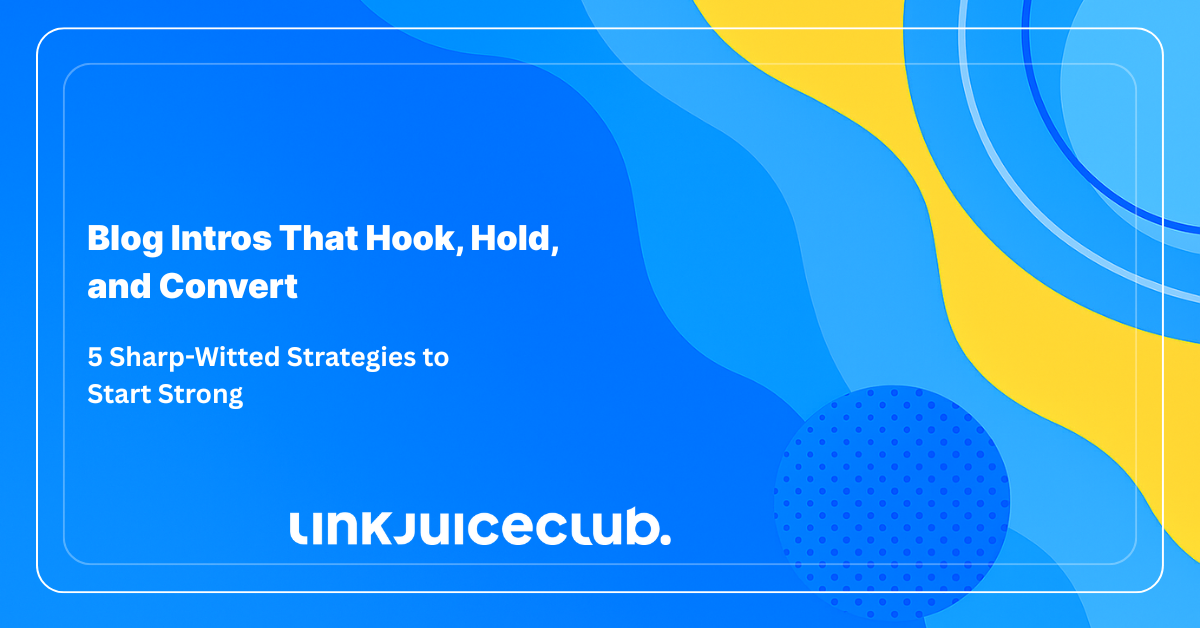
Blog Intros That Hook, Hold, and Convert: 5 Sharp-Witted Strategies to Start Strong
Your blog intro is your handshake, your headline’s wingman, and your one-shot moment to whisper “keep reading” before your visitor bolts.
Let’s call it what it is: Blog intros make or break your content. If the opening fizzles, your reader’s already gone — no matter how brilliant the body is. But if you can tap into what they’re searching for and set the tone like a pro? You’ve won half the battle in a single scroll.
This isn’t about clever quips or gimmicks. It’s about strategy that sticks:
- Creating instant clarity 🔍
- Building curiosity without clickbait 🎯
- Proving you’re worth their time, fast ⏱️
Let’s dig into five rock-solid ways to turn ho-hum blog intros into magnetic lead-ins that boost dwell time, lower bounce rates, and make your content impossible to ignore.

1. Match Their Mindset — Not Just Their Keywords
Let’s start with a reality check:
If your intro doesn’t mirror the reader’s intent, they’re gone.
You’ve got seconds to prove you understand why they clicked. That’s not just SEO — that’s survival.
Set Clear Expectations
Think of your intro as the GPS. If it’s vague, misleading, or slow to load meaning, people hit “back” faster than you can say bounce rate.
To keep them moving forward:
- Signal the purpose of the article immediately
- Use bold, clear language — no fluff, no filler
- Outline where they’re headed (without giving away the whole ride)
About Those Hooks…
Hooks are great — but they’re not the whole story. A killer one-liner might catch their eye, but it’s the follow-through that keeps them around.
📌 Don’t just drop a zinger. Instead:
- Reflect their problem back at them
- Show empathy and authority
- Lead them into the body with purpose
How to Nail It Every Time
- Use search intent as your North Star 🔍
- Tie every sentence to a question the reader might be asking
- Create flow with strong transitions, not guesswork
A smart blog intro isn’t clickbait — it’s a contract. And trust? That starts before they even scroll.
2. Storytelling: Your Secret Weapon for Blog Intros That Stick
Numbers get skipped. Stats get skimmed.
But a story? That’s what sticks.
We’re wired for it. Since cave paintings and fire circles, humans have leaned in when something sounds like a story.
Want to write intros that actually get read? Then don’t explain. Narrate.
Why Storytelling Works
It builds instant connection.
It paints your reader into the picture — without asking them to think too hard.
Story-driven intros:
- Tap into emotion before logic 💬
- Make complex topics feel human 💡
- Build trust faster than bullet points ever could
Ways to Use Storytelling in Blog Intros
1. Paint the Scene
Drop your reader right into the action. Set the tone, mood, or tension — before they even know what the article’s about.
Example: Writing a blog for a project management app? Try this:
“Your deadline’s in three hours. Your inbox is exploding. The spreadsheet has six versions and nobody knows which one’s final. Sound familiar? Let’s clean up that chaos — once and for all.”
2. Share a Personal Snapshot
A little vulnerability goes a long way. If you’ve been in your reader’s shoes, say so. Authenticity builds loyalty.
Example: For a time-tracking tool’s blog post on burnout:
“Last year, I found myself checking emails at midnight — again. That was my third straight month working 60+ hours. Sound familiar? This isn’t just a blog post. It’s how I reclaimed my time.”
Tease a Mystery
Curiosity is a powerful magnet. Set up a question — then promise the answer if they keep reading.
Example: Launching a piece on SEO myths?
“You’ve optimized everything. The traffic still won’t budge. What if the problem isn’t your content… but your beliefs about how SEO actually works?”
Use Stories Strategically
Not every intro needs a saga. But every great intro feels like a story — even if it’s just two sentences.
Keep these in mind:
- Match the story’s tone to your audience
- Don’t overinflate — stay relatable, not theatrical
- Tie the story back to the value of the article
Stories don’t just entertain — they convert. Use them to frame the reader’s problem, and position your post as the solution.
3. Ask, Quote, and Captivate: Turning Questions into Click Magnets
If blog intros were first dates, questions and quotes are your icebreakers.
They disarm, invite, and — when used right — pull your reader closer with almost magnetic force.
Why Questions Work Like Magic
A well-placed question isn’t just filler — it’s a trigger.
It makes the reader pause, think, and engage before you’ve said much else.
Here’s what the right question can do:
- Frame the problem your post solves 🧩
- Create tension or curiosity (“Wait, do I know the answer?”)
- Position the reader as part of the conversation — not just a spectator
Example: For a blog about digital privacy:
“Ever wonder who’s watching you online — even when you’re in ‘Incognito Mode’? The answer might make you rethink your entire browsing routine.”
How to Use Quotes (Without Sounding Like a Motivational Poster)
Quotes add instant weight — if they bring value.
A random line from Einstein? Not helpful. A razor-sharp insight from someone your readers trust? That’s gold.
Smart ways to use quotes in intros:
- Validate your topic with expert insights
- Offer a surprising take or challenge a common belief
- Reinforce trust early by aligning with credible sources
Just be sure:
- The quote supports your reader’s intent, not the opposite
- You credit your source properly (and link, if appropriate)
- It adds clarity — not confusion
Example (for a leadership blog):
“As Simon Sinek once said, ‘A boss has the title. A leader has the people.’ So… which one are you becoming?”
Quote & Question Pitfalls to Dodge
Not every quote is a mic drop. And not every question adds depth.
Avoid these rookie moves:
- Asking obvious or vague questions (“Want to succeed?” — um, yes?)
- Using negative quotes that conflict with the reader’s goal
- Quoting just to sound smart — relevance matters more than brilliance
Quick Formula: Story + Question + Quote = Intro That Clicks
Want a winning structure? Try this:
- Open with a mini-story or relatable scene
- Ask a question that highlights a challenge
- Drop a quote that frames the solution
It’s conversational, credible, and infinitely scrollable.
4. Blog Intros That Win Both Humans and Algorithms
SEO and reader engagement aren’t enemies — they’re dance partners.
The trick? Learning how to lead both.
Gone are the days of keyword stuffing and backlinks-for-hire. Google’s Helpful Content update rewrote the rules, and blog intros have become one of the most critical battlegrounds for attention and authority.
So how do you balance optimization with real human connection?
Let’s break it down 👇
Advanced SEO Tactics for Blog Intros
These aren’t just buzzwords — they’re strategic plays designed to rank and resonate.
1. Semantic Search Optimization
Search engines don’t just match keywords — they decode meaning.
To align with that:
- Focus on intent, not just exact matches
- Use synonyms and keyword variations naturally
- Mirror how your audience talks, not just how they type
Example: Instead of repeating “Blog Intros” 10 times, sprinkle in:
- “opening paragraph”
- “first lines of a blog post”
- “intro copy that hooks”
2. Structure for Scanners and Crawlers
Google loves clean structure — and so do readers.
Make your intro easy to digest by:
- Using H2s and H3s to break up sections
- Front-loading key ideas
- Wrapping value in tight, punchy sentences
Want to land a featured snippet? Use intro paragraphs that directly answer the query in 40–50 words.
3. Leverage Natural Language Processing (NLP)
Google’s NLP understands searcher phrasing better than ever — and so should you.
To capitalize:
- Analyze how your audience asks questions
- Reflect those phrases back in your intro
- Use conversational tone with topical depth
Tool Up: Platforms like AlsoAsked, AnswerThePublic, or even Google’s “People Also Ask” box reveal real-world phrasing gold.
SEO vs. Engagement? Don’t Choose — Blend
Remember: A blog intro can rank at the top and still flop with readers if it’s robotic.
But with the right balance:
- You signal authority to Google
- You earn trust from humans
- You drive action from both
5. Use Data to Refine Blog Intros That Actually Hit the Mark
Creating high-converting blog intros isn’t a guessing game — it’s a feedback loop.
When you treat metrics like breadcrumbs, your audience shows you exactly where your intro lands… or falls flat.
Feedback Is Fuel — If You Know Where to Look
Your readers are leaving you signals in every click, scroll, and share.
Comments? They reveal what your intro didn’t explain.
Social shares? Those intros sparked something worth passing on.
Low time on page? That intro lost their attention before it even got to the meat.
Sprinkle in tools like heatmaps, scroll depth trackers, and GA4 dashboards — and suddenly your intro has its own performance report card.
From Metrics to Mastery
Here’s how to interpret the signals:
- Bounce Rate: A red flag your opening didn’t match the search intent
- Time on Page: Measures how much your intro pulled them in
- Click-Through Rate: Reveals whether your lead-in created enough curiosity
These aren’t just numbers — they’re your roadmap.
Your Move: Let the Numbers Guide the Rewrite
The goal isn’t to chase perfection — it’s to stay responsive.
When you listen to the data and let your intros evolve, every post gets stronger.
Small tweaks = big lifts.
Track. Test. Adapt. Repeat.
The Bottom Line: How to Turn Blog Intros Into Engagement Engines
Your blog intro isn’t just a warm-up — it’s the make-or-break moment where attention is either earned or lost.
To recap, here’s how to write intros that connect, convert, and climb the SERPs:
- Match the reader’s mindset by reflecting intent from the first line
- Use storytelling to create emotional connection and curiosity
- Leverage quotes and questions to spark engagement early
- Balance SEO with readability, using structure and semantics to win both algorithms and humans
- Use data to refine — let metrics guide what works and scale it with confidence
Every intro is an invitation.
Make yours impossible to ignore.





